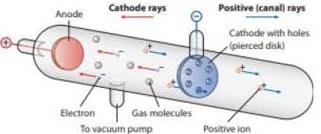Cathode rays are streams of negatively charged particles, or electrons, that are accelerated from a cathode to the anode within a vacuum tube by an electrical potential.

Before the electrons are accelerated, they must be extracted from a atoms and be on the surface. Electrons are first extracted from from the nuclei to a metal surface when the metal is heated. The heat energy increases energy of an electron so that it is able to break loose from the force of attraction of the nuclei. This process where electrons are emitted to the surface is known as thermionic emission.
When a material is heated, its atoms vibrate more vigorously. This thermal energy can be transferred to the electrons in the material. If the temperature is high enough, some electrons gain enough energy to overcome the work function of the material—the minimum energy needed for an electron to escape from the surface of the material into the vacuum or surrounding environment.
Thermionic Emission for cathode rays
In thermionic emission, a cathode is heated from low voltage supply so that electrons can be extracted to the surface. Another higher voltage is then used to accelerates the electrons produced towards an anode. A typical setup used for thermionic is as shown below.

A cathode which is inside the evacuated glass tube is made with mixture of barium oxides and strontium oxide. The resulting metal oxide is of low work function so that the minimum energy required to remove an electron from it’s atom to the surface is low.
In the setup, a low voltage of about 6V drives a current through the heating filament which then heats the cathode.
Initially the reading on the milliammeter(mA) is zero. When the heater circuit is switched on, some current is observed on the milliammeter after sometimes meaning that current circuit between cathode and the anode has been completed. As you can see, there is a wide gap between the anode and the cathode, but when the heater current is switched on, the heater circuit is complete in the gap.
This is because cathode the electrons produced by the cathode are able to move to the anode across the gap. How do they do that?
The hot cathode emits electrons which are then attracted to to the anode due to the 12V accelerating potential. This acceleration ensures electrons are able to move across the gap hence making the circuit complete. This setup help us be able to observe and explain thermionic emission and the cathode rays inside the evacuated glass tube we call cathode ray tude.
Production of cathode rays
Cathode rays are usually produced in cathode ray tube (CRT).

Electrons produced at the cathode by thermionic emission are accelerated towards a fluorescent screen connected to the anode which is connected to the positive terminal of an extra high tension (E.H.T) source. When the cathode rays are stopped by the fluorescent screen, the kinetic energy of the cathode causes the screen to glow.
The reason the tube is evacuated is to ensure electrons do not collide with gaseous particles before reaching the screen. If electrons collides with other particles, ionization of the gas in the tube may occurs causing different observations from the one intended. Again collision with some other particles may cause electrons to loose their energy and probably not able to reach the screen. The movement of cathode rays in a cathode ray tube is illustrated in the table figure below:

Questions
- What is thermionic emission
- Illustrate production of cathode rays using a suitable diagram.
- Explain why it is important for a cathode ray tude to be evacuated.


Leave a Reply